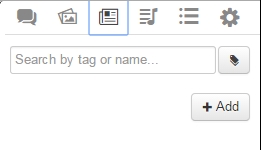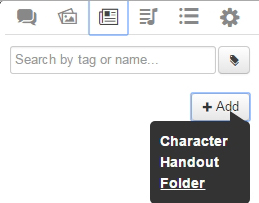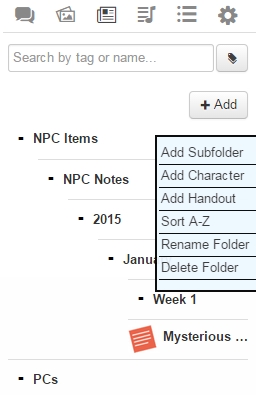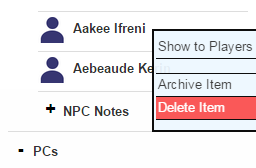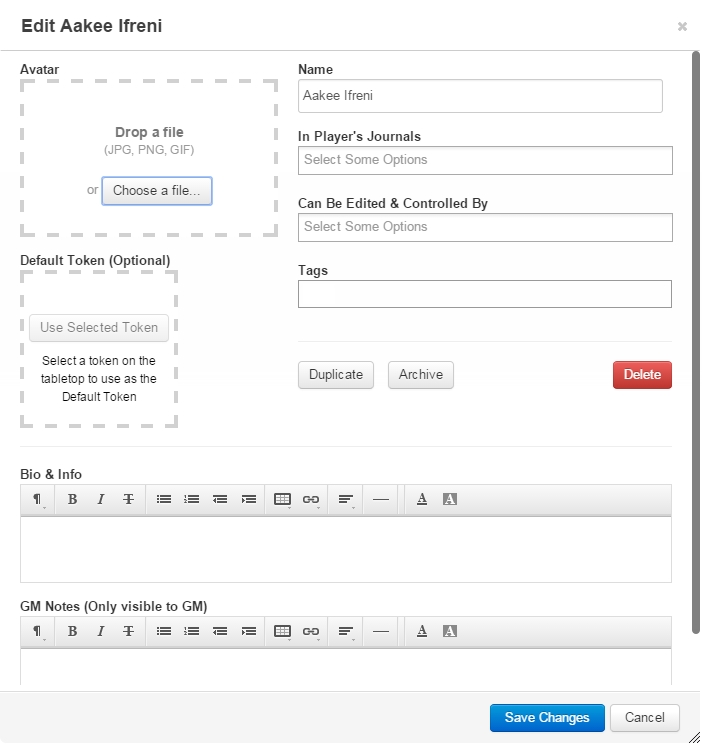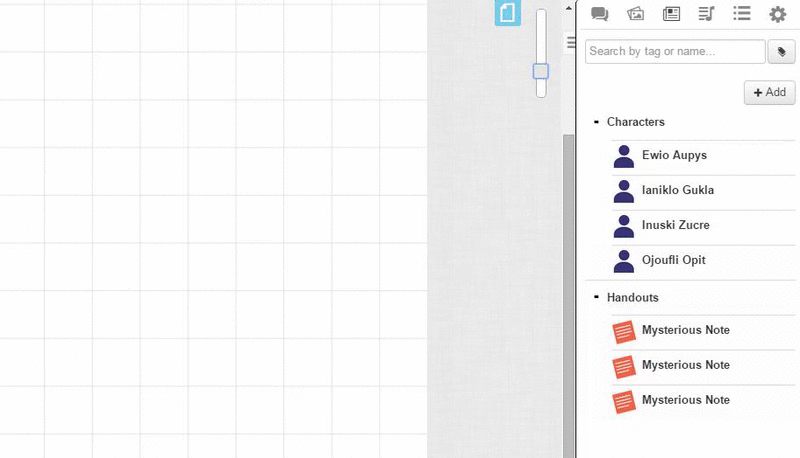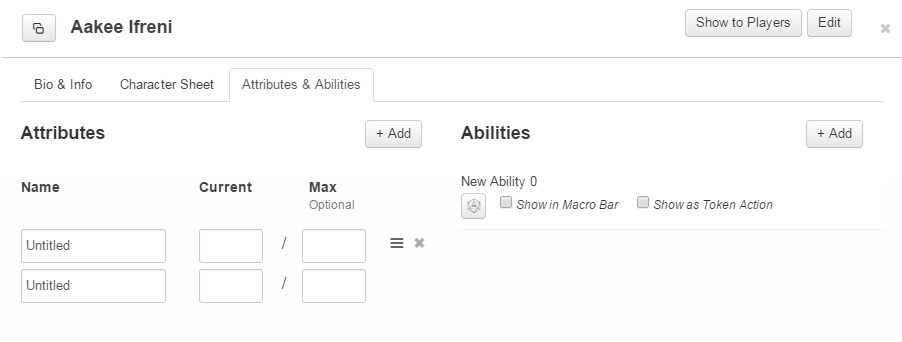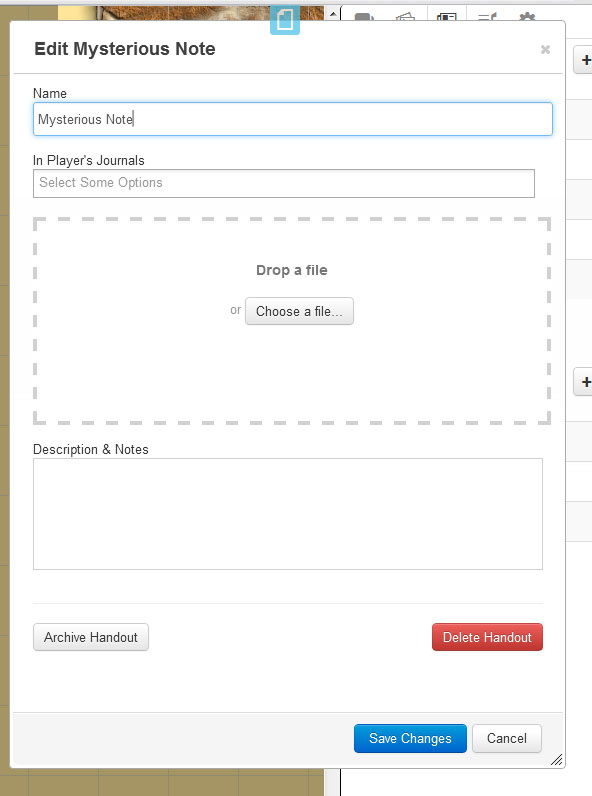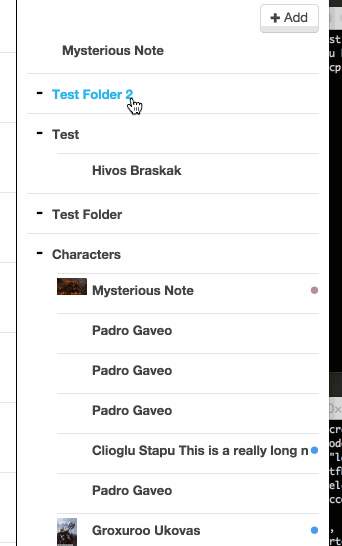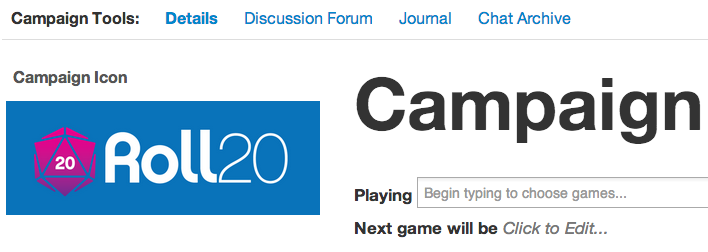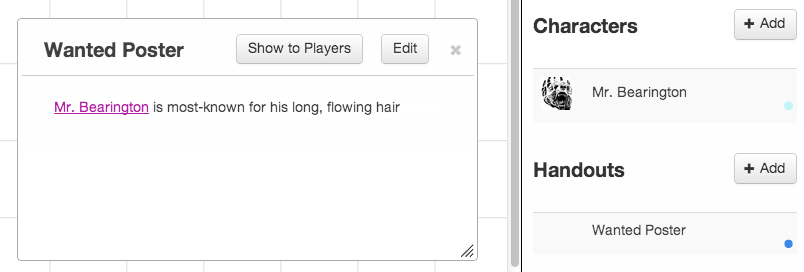Journal
From Roll20 Wiki
The Journal is the third tab of the Sidebar. This feature allows GMs to create Characters, Handouts, and organizational Folders for their campaigns. The Journal serves as a central repository for campaign information. These items can be made private or shared with other players. Shared items can be viewed by players with access from this same tab.
Add a Character, Handout, or Folder to the Journal by clicking the button labeled + Add within the Journal tab. Select an item from the dropdown list to add it to the campaign Journal.
Contents |
Folders
Folders can be used to help organize Characters and Handouts within the Journal.
Adding Folders
Add a new folder using + Add button as described at the top of this page, making sure to select Folder from the dropdown menu. Follow the instructions on the prompt to name the folder and hit OK to add the folder to the Journal.
Folder Options
Right click the folder to reveal a list of options. Add Subfolders, Characters, and Handouts using this method to automatically nest 4 additional folders under the right-clicked folder. Items can also be moved in and out of folders manually using the mouse, see Reorganizing Journal Items for more detail.
| Note: Due to the limited space on the Sidebar, only 4 additional folders can be added. Characters and Handouts can only be added to the most deeply nested folder by using the right-click options menu to add items. |
You can sort alphabetically, rename or delete the folder from this menu as well. Deleting folders will not delete the items inside. All items in the deleted folder will be moved to the root folder. Using the Delete Folder option requires your approval upon use, confirm when prompted to initiate your action.
Characters
Characters are intended to represent either PCs or important NPCs in your Campaign. Each Character has a name, an avatar which represents the Character, Attributes, Abilities and a Bio and a GM Notes section.
Adding Characters
Add a new Character using + Add button as described at the top of this page, making sure to select Character from the dropdown menu or by right-clicking a folder and selecting Add Character from the Folder Options menu. The system randomly generates a placeholder name and creates the Character.
| Useful Tip: Adding new Characters or Handouts using the right-click method places them directly into the right-clicked folder. Click the character name to open, edit, or add details. |
Character Options
Right-click the Character name to reveal a list of options, including Show to Players, Archive Item, or Delete Item. Your approval is needed upon use of the Show to Players and Delete Item options - confirm when prompted to initiate your action.
Character Window
Click the Character name from the Sidebar to open the info window. To the left of the Character name is a popout button. Click to pop your info window out into a new browser window. Visit the My Settings page to set popout windows to automatic. Click the Show to Players button to reveal the Character to all players or click the "Edit" button to customize.
Bio & Info Tab
Information added to the Character window using the Edit button will be displayed here. Click the Edit button to further customize Character details.
Avatar
You can upload an Avatar to represent this Character in the Journal listing as well as the Chat interface. Just drag and drop an image from your computer, or drag and drop an image from the Art Library search results into the box.
Name
Change the randomly generated placeholder name to a Character name of your choice.
In Player's Journals
By default, only the GM sees the Character. To allow other Players to see the Character in their Journal tab, add their names to the "In Players Journals" field. You can also choose "All Players" to allow everyone to view the Character.
Players who can view the Character will see the name, avatar, and any text typed on the Character's Bio & Info tab.
Can Be Edited & Controlled By
The Controlled By field allows you to give Players in your game the ability to "speak" as that Character in the Text Chat. They are also able to edit the Character's information if they control it. In addition, if you use the Represents Character feature of the Tokens Settings, players who have permission to control this Character will also be able to control any tokens that represent this character. You can also choose "All Players" to allow everyone to control or edit the Character.
Default Token
The Default Token field gives you the ability to select a token on the tabletop to use as the default token for this Character whenever it is added to the table. Just select a token, then press the "Use Selected Token" button. A copy of the token will be stored, including any notes, player permissions settings, and bar values and links. You can then drag-and-drop the Character from the Journal listing in the right sidebar onto the tabletop, and a new copy of the Character's default token will be added to the table.
Once a Token is tied to a Character in the Journal, a Shift+Click on the Settings icon when a token is selected or Shift+Double Clicking on the token directly will open the attached Character; Alt+Click opens the character to the Attributes & Abilities tab. You can also drag and drop the character name from the Journal tab to add tokens directly to the tabletop once a token has been tied to its Character.
| Useful Tip: Set up all your tokens ahead of time and assign them to Characters. Then when your players join your game, just give them control of the Character and they'll be able to control all the tokens for that Character right away. |
Tags
The Tags field allows you to tag the Character so that you can quickly find it later using the Search box at the top of the Journal tab in the sidebar.
Duplicate
Using the Duplicate feature will create another Character Journal. This can be useful when using a character or NPC/monster "template".
Archive
Archiving the Character will put it in long-term storage. You can easily return it to the Journal tab by clicking on the "Archived Items" link that will appear in the list after you've archived at least one Character.
Delete
Deleting the Character will permanently remove it from the Campaign, and cannot be undone.
Bio & Info Field
The Bio & Info field allows you to input information about the Character.
GM Notes Field
Use the GM Notes area to add additional notes that only the GM can see.
| Note: Both Bio and GM Note fields have a plethora of formatting options available, as well as, the ability to add tables and copy and paste from PDFs. |
Character Sheet Tab
Your Character may also have a Sheet tab, which is a way to display information about the character which mimics a paper character sheet for the game you are playing. Your GM will set this feature up if it's available for your game. Filling out the sheet is straightforward, just click on any field and enter your information. Some fields will also auto-update based on other information (for example, your Strength Modifier may auto-calculate based on the Strength of your Character). Finally, Character Sheets may also have roll buttons which you can click to quickly perform skill checks and other actions (such as attacks) for your Character. Again, consult with your GM for the details on your specific game.
More information on Character Sheets, including how to set them up if you're the GM of the game, are available in the Character Sheets article.
Attributes & Abilities Tab
Characters also have Attributes and Abilities, which are used to track stats about the Character and store rolls and other chat commands that are frequently used by that Character. To access the Attributes and Abilities, click on the "Attributes and Abilities" tab along the top of the screen.
Attributes
You can add Attributes to your Characters. Each attribute has a name, as well as, a current and (optional) max value. Any players that you give permission to edit/control the Character will also be able to edit the Attributes. Attributes can be used as variables in Macros and Abilities.
Abilities
Abilities are designed to work in conjunction with Attributes. Abilities work almost exactly as Macros. You can put any valid chat command (rolls, emotes, etc.) into the ability. By using an Attribute that is assigned to a Character as a variable modifier, you can create complex Character-based Abilities. Type "@" to view a list of Attributes that can be used. Since the variable used in the Ability is linked to a Character Attribute, the value will sync when changed in the Character editor. You can easily add and remove Abilities from your Macro Quick-Bar by selecting the Character from the Journal Tab. Shift+Clicking on an Ability on the Macro Quick-Bar will open that Character's Ability editor. Abilities can also be used as Token Actions which is a token specific macro feature.
Finally, you can hover over Attributes and Abilities to drag and drop to re-order them or delete them.
Handouts
Handouts are very similar to Characters and have some of the same fields. The main difference is that Handouts are designed to be either one large image or a long description (or both).
If you include an image that's larger than the handout window, a magnifying glass will appear over the image when you view the handout. Clicking on the image in the handout will display either the original dimensions or a full-screen version of that image.
Clicking the F11 key (on most Web-browser programs) will make the image even larger because the browser toolbars will disappear and give the image more height. Press F11 again to restore.
You must put the Handouts into Players' Journals using the "In Player Journals" field in order for Players to be able to see them. After you've given Players permission to view the Handout, you can also use the "Show to Players" button to force the Handout to open on the screens of Players who can view it.
You can also drag and drop a Handout from the Journal tab in the right sidebar onto a player. That player will be given permission to view the Handout, and it will also appear on their screen immediately.
Reorganizing Journal Items
Hover your mouse over the item you wish to move. Grab the "handle" that shows up along the left-side of the item name. Drag the item just below the folder that you want to move it to and then move the file to the right before dropping it in the folder.
Minimizing Journal Entries
You can minimize journal entries by double clicking upon any currently opened character journal or handout. This will shrink the item down to a small translucent title bar with the name of the entry on it and a couple buttons listed on the bar’s right side. You can click and drag this title bar to wherever is most convenient on the browser. To maximize the journal entry again, simply double click on the minimized title bar.
While minimized, the Edit button is still available to access for both character journals and handouts. In the case for handouts, there’s also a “Show To Players” button option.
You can close minimized journal entries by clicking on the X button on the far right of the title bar.
| Note: If you close a minimized journal entry it will remain so when you open it again from the Journal Tab on the Sidebar. |
External Journal Access
If your GM is a Supporter or Mentor subscriber, you can easily view your Journal entries outside of the app. Located on the Campaign Details page, along with access to your Campaign Forums, and Chat Archive.
This is great for checking up on things in-between gaming sessions without the hassle of loading up the whole tabletop. You can also keep the external Journal open in a separate tab or browser window, or even on another screen.
The external Journal updates in real-time. So if a change is made to a character’s bio, you don’t need to reload, you’ll see the change right away. This really enables you to use the external Journal as a play aid during your Roll20 games.
Link Between Journal Entries
You can easily link your journal entries together inside the game.
Just put single brackets around the name of a character or handout (for example: “[Mr. Bearington] is most-known for his long, flowing hair”), and when you save the entry we’ll automatically create a clickable link that will open that other journal entry.
It works both inside and outside the app, and it’s smart enough to obey player permissions as well (so a player can’t open a handout they don’t have access to, even if they see a link to that handout).
You can use the links in character bios, GM notes (both for characters and tokens), and handout notes fields. Use links to tie entries together, or even create a “table of contents” page for your campaign to quickly access your most-used journal items.





